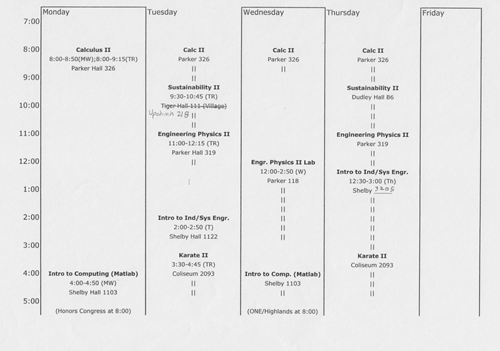Acting with Tables for Scheduling Life Activities
Alexandra also acts with tables as she organizes her life’s activities. Like many undergraduates balancing a full load of classes (and often more), activities related to the academic programs they are involved in, campus jobs, and a full slate of other commitments, Alexandra has an extremely busy schedule. Managing her engagements involves a variety of tables, including the small spiral-bound daily planner she carries in her purse and a large calendar that hangs above her desk in her dorm room. The one that sees the most use, though, is the schedule planner she creates for herself and a few close friends at the beginning of each semester.
In the brief video clip (below) from one of our interviews, Alexandra describes the schedule planner she creates for each term.
Created based on the previous versions she collaboratively made with her father and mother to manage the complexity and fluidity of her homeschooling, Alexandra’s schedule planner consists of a cover page and a series of weekly pages that are printed, covered with a transparent sheet for durability, and then spiral bound.
The cover page Alexandra created for spring 2011 (see Figure 7 at right) indicates the day, time, and location of her regularly occurring commitments throughout the semester by locating them in relation to the days listed along the top of the table and the times listed along the left-hand side. The cover page emphasizes the days, times, and locations of her classes for the semester, but it also includes some of her other regularly occurring events that occur from Monday through Friday. At the bottom of the cover page for spring 2011, for example, Alexandra lists her meeting with the Honors congress at 8:00 on Monday evenings and a program she attends at a local church at 8:00 each Wednesday.
Alexandra’s attention to the functionality of the table is evident in her comment regarding how she “messed up” by not including horizontal lines in each cell of her cover page, an oversight she corrected when she made the cover for her boyfriend’s planner. In the video, Alexandra does not elaborate on why she saw this as a misstep, but one can understand how the lack of lines obscures the times for those classes listed on the right-hand side of the table. The absence of such lines could also create difficulties if Alexandra needed to write in the day, time, and location of any regularly occurring activities Alexandra committed to after the planner was printed, assembled, and bound.
The cover page of the planner opens to a series of pages indicating her activities for each week of the semester (see Figure 8 at right). The weekly pages she created for her spring 2011 planner offer columns for each of her courses and for her “Other To-Do’s.” The days of the week, Monday through Sunday, run from top to bottom along the left-hand side of the page. The lines in the cells provide Alexandra with a space to write down the specific information about her commitments for each week. Working from the assignments indicated in her syllabi for that semester, Alexandra indicates what she needs to complete for each class meeting, whether finishing problems one through twenty-four for Calculus II or reading “The Efficiency Dilemma” for her Honors Sustainability II course. Like the cover page, the weekly pages emphasize Alexandra’s courses, but the “Other To-Do’s” column provides space for listing anything else she needs to accomplish.
While the number and headings for the columns of the cover page stay the same from semester to semester, those of the weekly pages change depending on the number of classes Alexandra takes and the other kinds of regularly occurring key activities she plans to participate in. For one semester, she added a column for her participation in Engineers without Borders. For another semester, she included columns for her part-time work for the university’s sustainability office and her involvement with a local church's youth program. Alexandra’s ongoing adjustments to the tables of the weekly pages echo the practices of the ecologists Roth (2003) studied who, upon “realiz[ing] that their perceptual apparatus as embodied by the tables is incomplete,” add or remove rows or columns or redefine the labels of existing columns (p. 243).
The tables Alexandra creates and acts with on a daily basis to plan her activities allow her to order her jumble of classes and commitments for each semester according to their dates, times, and locations. In doing so, they also accomplish many of the same functions as the ones she acts with for her engineering activities. The pages of her schedule planner remind Alexandra what she needs to accomplish for each engagement and allow her to plan when she can schedule future activities. The tables also coordinate information from a number of other inscriptions, something Alexandra indicates in her comments about re-representing on the pages of her planner the days, times, and locations of her classes and the key dates and assignments from her course syllabi. They also coordinate information with the daily planner she keeps in her purse and the wall calendar in her dorm room. The tables also serve as conscription devices (Roth, 2003, p. 18) in that they function as inscriptions that people gather over as they make decisions about days, times, and locations when they can get together. Alexandra and Kevin’s efforts to schedule interviews, for example, were regularly mediated by talking over and through her schedule planner and the small calendar Kevin carries in his wallet.


